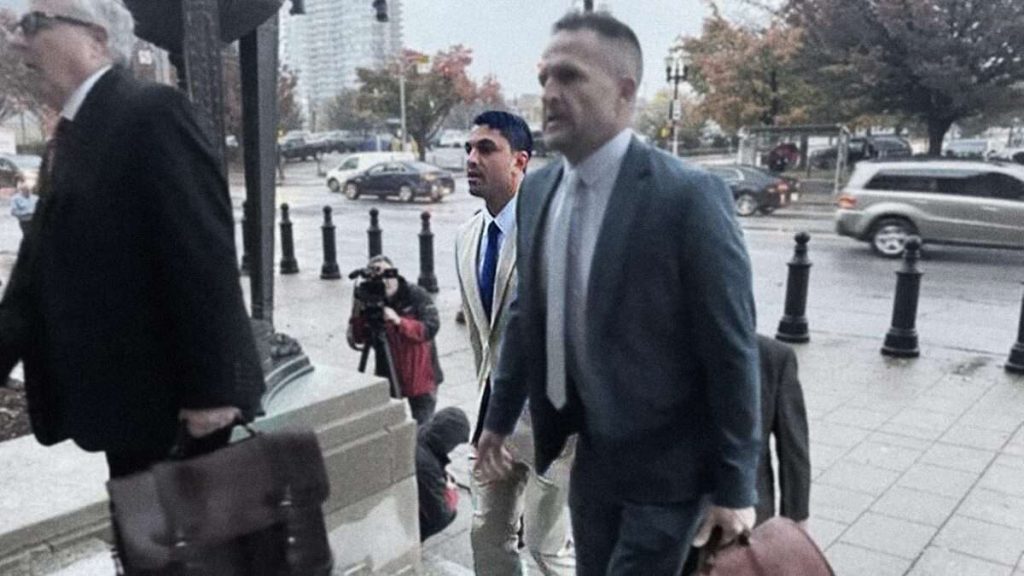
Louisville, Kentucky, police did a lot of questionable things before, during, and after the March 2020 drug raid that killed Breonna Taylor, a 26-year-old EMT and aspiring nurse. Their lapses included a misleading, legally deficient search warrant affidavit; a reckless, middle-of-the-night home invasion that led to a lethal confrontation; and a conspiracy to cover up the misrepresentations that preceded the raid. But the most baffling aspect of the incident was Detective Brett Hankison’s decision to blindly fire 10 rounds from outside Taylor’s apartment through a bedroom window and a sliding glass door that were covered by blinds and curtains.
On Friday, after deliberating for more than 20 hours over three days, a federal jury in Louisville convicted Hankison of willfully violating Taylor’s Fourth Amendment rights under color of law by firing five rounds through the bedroom window. Although none of the bullets struck Taylor, federal prosecutors argued that Hankison endangered her life by unlawfully using deadly force.
Because the charge “involved the use of a dangerous weapon and an attempt to kill,” Hankison faces a maximum sentence of life in prison. The jury acquitted him of a second count under the same statute, which alleged that he violated the constitutional rights of Taylor’s neighbors, who were endangered by bullets that penetrated their apartment.
Hankison, who was fired from his job with the Louisville Metro Police Department in June 2020, is the only officer directly involved in the raid to be convicted of a crime. In March 2022, a state jury acquitted him of wanton endangerment, a charge based on the same use of force. Hankison was indicted on federal civil rights charges five months later. Last year, his first prosecution on those charges ended with a mistrial after jurors failed to reach a verdict.
During his second federal trial, Hankison again testified that he was trying to help two fellow officers inside Taylor’s apartment, Sgt. Jonathan Mattingly and Detective Myles Cosgrove, thinking they were under sustained fire. Here is what was actually happening, as described in a Justice Department press release about Hankison’s conviction:
During the execution of the warrant at Taylor’s home, officers knocked on Taylor’s door and announced themselves as police at approximately 12:45 a.m. No one answered the door, and the officers saw no indication that anyone in the home was awake or had heard their announcement. The police then rammed the door open and Taylor’s boyfriend, believing that intruders were breaking in, fired his handgun one time at officers, two of whom fired back, hitting and killing Taylor.
Taylor’s boyfriend, Kenneth Walker, has consistently said he heard no announcement and had no idea the intruders who had broken into the apartment were police officers. He was initially charged with attempted murder of a police officer, but prosecutors dropped that charge two months later, implicitly conceding that Walker had a strong self-defense claim. The bullet he fired struck Mattingly in the leg. In response, Mattingly and Cosgrove fired a total of 22 rounds down a dark hallway, where Taylor, who was unarmed, was standing near Walker.
Hankison, who could not see what was happening because he had moved from the doorway to the side of the apartment, testified that he mistook his colleagues’ hail of bullets for gunfire from a semi-automatic rifle. “I saw those windows and doors lighting up,” he said. “It looked like there was a strobe light in there….In my mind, an AR-15 is being shot, and it sounds like it’s getting closer and louder.” He added that it “sounded like a semiautomatic rifle making its way down the hallway and executing everybody.”
Even so, Hankison’s response is hard to fathom, since he had no way of knowing who might be hit by his rounds. The Associated Press notes that “several witnesses, including Louisville’s police chief,” testified that Hankison “violated Louisville police policy that requires officers to identify a target before firing.”
Defense attorney Don Malarcik nevertheless insisted that Hankison had done nothing wrong. “He did exactly what he was supposed to do,” Malarcik told the jurors during his closing argument. “He was acting to save lives.”
Not so, said Assistant U.S. Attorney Michael Songer. Hankison “violated one of the most fundamental rules of deadly force,” Songer told the jury. “If they cannot see the person they’re shooting at, they cannot pull the trigger.”
According to Yvette Gentry, Louisville’s former interim police chief, Cosgrove—who fired 16 rounds into the apartment, including the one that killed Taylor—did something similar. Gentry canned Cosgrove in December 2020, saying he had fired “in three distinctly different directions,” which indicated he “did not identify a target” and instead “fired in a manner consistent with suppressive fire, which is in direct contradiction to our training, values and policy.”
Like Hankison, Cosgrove said he mistook police gunfire (Mattingly’s) for incoming rounds. He told investigators he was “overwhelmed with bright flashes and darkness,” which led him to believe “there’s still these gunshots happening due to those bright lights.” Cosgrove, who later found work as a sheriff’s deputy in Carroll County, Kentucky, suggested that he fired his gun without thinking. “I just sensed that I’ve fired,” he said. “It’s like a surreal thing. If you told me I didn’t do something at that time, I’d believe you. If you told me I did do something, I’d probably believe you, too.”
An investigation by Kentucky Attorney General Daniel Cameron nevertheless concluded that both Cosgrove and Mattingly had fired in self-defense, meaning that criminal charges were not justified. The fact that Walker also seems to have fired in self-defense underlines the recklessness of the “dynamic entry” tactics that police reflexively used in this case.
Taylor’s death inspired extensive local protests and became a leading exhibit for the Black Lives Matter movement, along with George Floyd’s death in Minneapolis two months later. In September 2020, the city of Louisville agreed to a $12 million settlement of a lawsuit filed by Taylor’s family. But except for Hankison’s unsuccessful prosecution, the raid did not result in any state charges.
The Justice Department, by contrast, obtained indictments against Hankison and three other current or former Louisville officers connected to the raid: former Detective Joshua Jaynes, who filed the search warrant affidavit; Sgt. Kyle Meany, who signed off on it; and Detective Kelly Goodlett, who allegedly “conspir[ed] with Jaynes to falsify the search warrant for Taylor’s home and to cover up their actions afterward.”
Jaynes’ affidavit, which linked Taylor to a former boyfriend’s drug dealing based on little more than guilt by association, “contained false and misleading statements, omitted material facts, relied on stale information, and was not supported by probable cause,” the Justice Department says. Jaynes, like Hankison, is charged with willfully violating Taylor’s Fourth Amendment rights. The former detective, who was fired in December 2020 for lying in his affidavit, is also charged with falsifying records in a federal investigation and with conspiracy for “agreeing with another detective to cover up the false warrant affidavit after Taylor’s death by drafting a false investigative letter and making false statements to criminal investigators.”
Meany faces the same civil rights charge. He is also charged with making a false statement to federal investigators by claiming that police sought a no-knock search warrant for Taylor’s apartment because the police department’s SWAT unit had requested it.
Goodlett, the detective who allegedly conspired with Jaynes, pleaded guilty in August 2022, a few weeks after her indictment. Jaynes and Meany have not been tried yet. Last August, a federal judge dismissed enhanced civil rights charges against them, rejecting the claim that their alleged misconduct “involved the use of a dangerous weapon” or “resulted in Taylor’s death.” Jaynes and Meany were re-indicted in light of that ruling last month.
“Brett Hankison was found guilty by a jury of his peers for willfully depriving Breonna Taylor of her constitutional rights,” Attorney General Merrick B. Garland said on Friday. “His use of deadly force was unlawful and put Ms. Taylor in harm’s way.” Although “this verdict is an important step toward accountability for the violation of Breonna Taylor’s civil rights,” Garland added, “justice for the loss of Ms. Taylor is a task that exceeds human capacity.”
The post Cop Who Fired Blindly Into Breonna Taylor’s Home Is Convicted of Violating Her Constitutional Rights appeared first on Reason.com.






